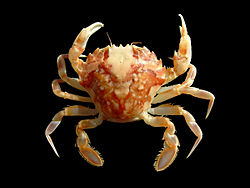This article relies largely or entirely on a single source .(December 2015) |
| Liocarcinus | |
|---|---|
 | |
| Liocarcinus marmoreus | |
| Scientific classification | |
| Kingdom: | Animalia |
| Phylum: | Arthropoda |
| Class: | Malacostraca |
| Order: | Decapoda |
| Suborder: | Pleocyemata |
| Infraorder: | Brachyura |
| Superfamily: | Portunoidea |
| Family: | Polybiidae |
| Genus: | † Liocarcinus Stimpson, 1858 |
| Type species | |
| Portunus holsatus Fabricius, 1798 | |
Liocarcinus is an extinct genus of crabs in the family Polybiidae. [1]